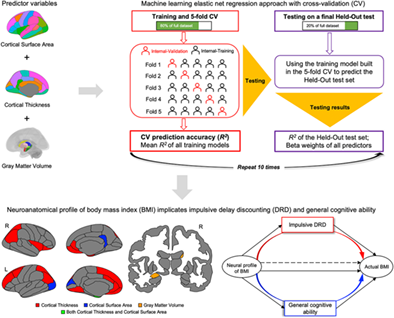Neuroanatomical profile of BMI implicates impulsive delay discounting and general cognitive ability
Abstract
Objective
Obesity is a disorder of excessive adiposity, typically assessed via the anthropometric density measure of BMI. Numerous studies have implicated BMI with differences in brain structure, but with highly inconsistent findings.
Methods
Machine learning elastic net regression models with cross-validation were conducted to characterize a neuroanatomical morphometry profile associated with BMI in 1100 participants (22% BMI > 30, n = 242) from the Human Connectome Project Young Adult project.
Results
Using five-fold cross-validation, the multiregion neuroanatomical profile substantively predicted BMI (R2 = 10.05%), and this was robust in a held-out test set (R2 = 8.87%). In terms of specific regions, the neuroanatomical profile was enriched for nodes in the default mode, executive control, and salience networks. The relationship between the morphometry profile and BMI itself was partially mediated by impulsive delay discounting and general cognitive ability.
Conclusions
Taken together, these findings reveal a robust machine learning-derived neuroanatomical profile of BMI, one that comprises nodes in motivational brain networks and suggests the functional links to obesity are via self-regulatory capacity and cognitive function.
CONFLICT OF INTEREST STATEMENT
James MacKillop is a Principal and Senior Scientist at BEAM Diagnostics, Inc. The other authors declared no conflict of interest.
Open Research
DATA AVAILABILITY STATEMENT
All data were provided by the Human Connectome Project, WU-Minn Consortium (Principal Investigators: David Van Essen and Kamil Ugurbil; 1U54MH091657) funded by the 16 NIH Institutes and Centers that support the NIH Blueprint for Neuroscience Research; and by the McDonnell Center for Systems Neuroscience at Washington University in St. Louis. The authors are grateful to the Human Connectome Project for open access to its data.






